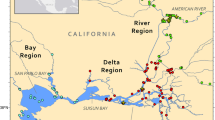Abstract
There has been much recent interest in restoration of salt-marsh habitats to their natural structure and function. However, the criteria for success of such restorations are not well-defined. As part of a larger program to evaluate the restoration of a former salt-hay farm bordering Delaware Bay, New Jersey, USA, we monitored the response of a large predator, the striped bass Morone saxatilis, to the restoration. During June to October 1998 we compared tidal and diel movements and food habits of juvenile and adult striped bass (n = 82, 212 to 670 mm fork length) between a restored marsh and an adjacent reference marsh with similar physical characteristics (depth, salinity, temperature). Striped bass movements at both sites were characterized by ultrasonic tracking with small, surgically implanted tags (21 d rated battery-life). Striped bass (n = 23, 421 to 610 mm fork length) were tagged and released near the main creek mouths at both the restored (n = 14) and reference (n = 9) marshes. At both sites, striped bass tended to move up the main creek during ebb tide. At the restored site, ebb tide upstream-movements ranged from 0.1 to 3.5 km from the main creek mouth (mean = 1.2 km). During the upstream movement, the fish typically stopped every 200 to 300 m (presumably to feed) for 1 to 2 h. At the reference site, few of the tagged fish moved farther than 100 to 200 m upstream from the main channel mouth at ebb tide, perhaps in response to somewhat lower dissolved oxygen at this site. During flood tide, tagged fish at both sites moved out into Delaware Bay, where they remained within 200 to 500 m of the creek mouth. Striped bass were sampled with gill nets to determine additional aspects of habitat use and food habits. Striped bass in both marshes were much more abundant at creek mouths (catch per unit effort, CPUE = 1.17) than in the upper reaches of the creeks (CPUE = 0.13). In the creek mouths, CPUE was greater at the restored site (CPUE = 1.8) than at the reference site (CPUE = 0.5). At both sites, most fish (approx. 80%) were collected on the late ebb or early flood tides, i.e. around low tide, when prey were presumably concentrated at the creek mouths. Stomach contents of bass from both restored and reference marshes (n = 59, 212 to 670 mm fork length) revealed that striped bass were eating mostly blue crab (Callinectes sapidus), grass shrimp (Palaemonetes vulgaris), sand shrimp (Crangon septemspinosa), mummichog (Fundulus heteroclitus), and various unidentifiable fishes (probably anchovies, Anchoa mitchilli, and Atlantic silverside Menidia menidia). In conclusion, the restored marsh supported larger numbers of striped bass than the reference marsh, but there was little difference in the pattern of creek utilization or food habits at either site. Thus, the restored marsh appears to be functioning in a similar manner to the reference marsh for these large predators.
Similar content being viewed by others
Author information
Authors and Affiliations
Additional information
Received: 28 June 1999 / Accepted: 1 August 2000
Rights and permissions
About this article
Cite this article
Tupper, M., Able, K. Movements and food habits of striped bass (Morone saxatilis) in Delaware Bay (USA) salt marshes: comparison of a restored and a reference marsh. Marine Biology 137, 1049–1058 (2000). https://doi.org/10.1007/s002270000421
Issue Date:
DOI: https://doi.org/10.1007/s002270000421




